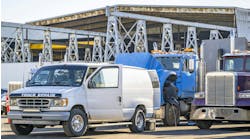FleetOwner launched its IdeaXchange initiative back in 2014 as a platform for industry thought leaders to share their ideas on a wide range of topics.
This year, our IdeaXchange contributors provided unique insights on topics such as freight efficiency improvements, fuel economy, how fleets can find creative ways to implement alternative fuels, electric vehicles and the path to decarbonizing trucking, business intelligence and KPIs, and, of course, driver appreciation and retention.
For this year's roundup, FleetOwner editors turned to data analytics to select our readers' picks for the top 10 IdeaXchange columns of 2022. Thank you, all, for making this initiative such a success on FleetOwner.com. We wish you all a safe, happy, and healthy new year!
10. Five questions fleets should ask to reinforce safe driving
Drivers can see if you are really committed to road safety based on how you address it in areas like your shop, administrative offices, yard, etc. Five key questions are important to ask. Read more
9. Making correct asset replacement decisions is vital
It has become increasingly important that fleet managers have complete information on how each asset in their fleet is performing. Each year, most fleets have a set number of trucks they trade in for new vehicles from their chosen manufacturer. Typically, age and given all the choices or miles are the determining factors in which assets to replace.
However, the current truck market is anything but typical. Patrick Gaskins, SVP of Corcentric Fleet Solutions, has more.
8. What it takes to keep drivers happy
In this column, Fontana also points out how the equipment fleets have available for their drivers and the way that equipment is spec’d plays a role in attracting and retaining drivers. Read more
7. One ICE strategy to transition to the electric future
All platforms will be capable of operating on diesel, natural gas, gasoline, and in some cases hydrogen fuels. While the platforms will feature a series of engine versions that are derived from a base engine, each version will operate on a single fuel. The company will start rolling out the engines but said they won’t all be available until 2024. Read more
6. Roadcheck 2022 concentrates on truck wheel ends
What is so special about wheel ends? Wheel-end components include the wheels, rims, hubs, and tires on commercial motor vehicles. Historically, violations involving those components account for about one-quarter of the vehicle out-of-service violations discovered during Roadcheck.
Think of it this way: You wouldn’t run a race in flip-flops, and you wouldn’t enter a field goal kicking contest with a broken big toe. The wheel ends are, literally, where the rubber meets the road. Read more
5. A salute to truck drivers
4. The right information leads to better inventory management
Having the proper parts in inventory when a truck needs maintenance service or a repair has always been important. However, in the past when you needed part overnight or in a matter of hours, proper inventory management was not as critical.
Now with parts deliveries stretching out to days or weeks, not having the right parts in your inventory could spell disaster, especially when you consider that a day of downtime costs a fleet $800 to $1,000, and that does not factor in the loss of goodwill from both customers and drivers.
David Seewack, founder and CEO of FinditParts, discusses how proper inventory management starts with having information about the maintenance and repair history of each asset in your fleet. Read more
3. The connection between maintenance and fuel economy
Jane Clark, VP of member services for NationaLease, explores the connection between a well-maintained truck and better fuel economy. Read more
2. Truck driver to officer: ‘Why did you stop me?’
1. With Tesla Semi, the 500-mile run is a new benchmark
In December, Tesla delivered its first battery-electric heavy-duty vehicle, the Semi, to PepsiCo. The long-awaited delivery (Tesla CEO Elon Musk initially promised delivery in 2019) provided a fair amount of information while at the same time leaving lots of unanswered questions.
In this column, Michael Roeth, executive director of the North American Council for Freight Efficiency, shares his takeaways from an event at the Tesla Gigafactory in Nevada. Read more













